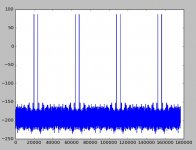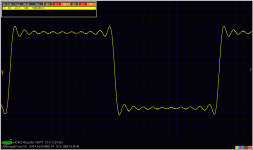If that peak amplitude is of very short duration, it falls outside our hearing ability anyways. So filtering it does no harm and is actually something that should be done, not just pre-ADC, but also before an amplification stage.
A small cymbal recorded at 24/192 exhibits energy well above 20kHz. It will be available in my dropbox for a limited time: Dropbox - Cymbal 24-192.wav - Simplify your life
Last edited:
My concern is that information is lost. In my example of 5x20 modulation, the envelope itself is information. And that information is split between upper and lower side bands. If one sideband is arbitrarily removed, will the envelope be the same.If that peak amplitude is of very short duration, it falls outside our hearing ability anyways. So filtering it does no harm and is actually something that should be done, not just pre-ADC, but also before an amplification stage.
Jn
My concern is that information is lost. In my example of 5x20 modulation, the envelope itself is information. And that information is split between upper and lower side bands. If one sideband is arbitrarily removed, will the envelope be the same.
I thought of something last night that might relate to the Nyquist and ITD issues. I suspect the phase rotation of the tone near fs/2 and its image is preserved and removing the image with a reconstruction filter changes the envelope but not the phase (or at least both channels are disturbed the same amount). This is why the short FFT's maintain the ability to track the frequency drift with such resolution.
Last edited:
What is needed for this claim to be accepted?If that peak amplitude is of very short duration, it falls outside our hearing ability anyways....
I know. I have spent the last few months avoiding this thread because of the acrimony.
I suspect I will again pull back for a while, as it is rather refreshing to not have to deal with those who simply come to argue.
Happy new year Scott.
Jn
Likewise, I dip in here every once in a while and leave sad that so many people have an axe to grind..and no wood to be found!😉
Happy New Year all...
Howie
I thought of something last night that might relate to the Nyquist and ITD issues. I suspect the phase rotation of the tone near fs/2 and its image is preserved and removing the image with a reconstruction filter changes the envelope but not the phase (or at least both channels are disturbed the same amount). This is why the short FFT's maintain the ability to track the frequency drift with such resolution.
We are in violent agreement.
Jn
Waveform and pattern recognition in sound may be affected........
Sound Envelopes. The envelope represents the varying level of a sound wave over time and is broken down into four areas; attack, decay, sustain and release. Jun 28, 2018
It could be another key to the mystery. Please explore that for me/us a lot more.
Duration Pattern Recognition in Normal Subjects and Patients with Cerebral and Cochlear Lesions. Three groups of subjects were tested on a duration pattern recognition task. ... Results indicated no significant difference in pattern recognition between the normal subjects and subjects with cochlear hearing loss.
and--
Pattern recognition (psychology) - Wikipedia
THx-RNMarsh
Sound Envelopes. The envelope represents the varying level of a sound wave over time and is broken down into four areas; attack, decay, sustain and release. Jun 28, 2018
It could be another key to the mystery. Please explore that for me/us a lot more.
Duration Pattern Recognition in Normal Subjects and Patients with Cerebral and Cochlear Lesions. Three groups of subjects were tested on a duration pattern recognition task. ... Results indicated no significant difference in pattern recognition between the normal subjects and subjects with cochlear hearing loss.
and--
Pattern recognition (psychology) - Wikipedia
THx-RNMarsh
Last edited:
Of course not. Rewritten: If I have a 15+25kHz twin tone and low-pass filter at 20kHz, will the envelope be the same?My concern is that information is lost. In my example of 5x20 modulation, the envelope itself is information. And that information is split between upper and lower side bands. If one sideband is arbitrarily removed, will the envelope be the same?
And btw, the concept of envelope is flawed. In the 5x20/15+25 example, it is hard to spot something that is a clear envelope, especially when one freq is not an integer multiple of the other. Envelope get clearer the less frequency difference we have. 19+20kHz do have a clear beating envelope, 15+25 doesn't.
A small cymbal recorded at 24/192 exhibits energy well above 20kHz. It will be available in my dropbox for a limited time: Dropbox - Cymbal 24-192.wav - Simplify your life
Thank you for providing
I will try the file as soon as possible, just as both 88.2 files provided by elektroj.
Hans
The 26uS only applies when you get to +-1 bit sine stream, if it is =+3 bits you get about 7uS or so, that means 1 -90db sine is difficult to locate in space, well if it is burried down in the backround noise I think you can expect it to be difficult to locate.
Ah, yes, of course, Richard has latched onto something of zero significance 😉
Ah, yes, of course, Richard has latched onto something of zero significance 😉
Really, he is beating us with experience. And he's not the only one.
Perfect for me. Nothing precede the attack. No excess of brightness, I can hear the stick, very natural sounding with no distortion.A small cymbal recorded at 24/192 exhibits energy well above 20kHz. It will be available in my dropbox for a limited time: Dropbox - Cymbal 24-192.wav - Simplify your life
Now, even normalizing the level, please note the very low average level. It gives an idea of what is requested as peak margins, and one of the problems of producing music in studios.
Last edited:
As cddb tried to show, mathematically synthesized signals of sampling show the entire result including the images and aliasing. You can not simply send the waveform that the bit stream represents out of a DAC without removing the images (any aliasing remains). Unless you're a NOS advocate.
The picture shows the spectrum (dB vs frequency) of the 20kHz example with 8x oversampling (352.8kHz) using zero stuffing. Using a general purpose math tool like Python/numpy I can make a perfect brickwall filter by simply zeroing all the bins past 22050 (this is a real only FFT) and get the expected perfect sine wave taking the inverse FFT.
Sad most of the argument here had been over simply that if you want to record an instrument that goes out to 50kHz you need to sample at 100kHz. This was always just plain obvious.
The picture shows the spectrum (dB vs frequency) of the 20kHz example with 8x oversampling (352.8kHz) using zero stuffing. Using a general purpose math tool like Python/numpy I can make a perfect brickwall filter by simply zeroing all the bins past 22050 (this is a real only FFT) and get the expected perfect sine wave taking the inverse FFT.
Sad most of the argument here had been over simply that if you want to record an instrument that goes out to 50kHz you need to sample at 100kHz. This was always just plain obvious.
Attachments
It was also plain obvious to us that were at the AES when the standard for CD's was adopted that the 44.1 k sample rate it was a compromise based on the available reused video recorder compatibility.
Subsequent standards all went for a higher sampling rate.
Subsequent standards all went for a higher sampling rate.
It was also plain obvious to us that were at the AES when the standard for CD's was adopted that the 44.1 k sample rate it was a compromise based on the available reused video recorder compatibility.
What does the theory have to do with 40yr. old economic decisions?
I suppose this is based on your listening test. During that test, how high of frequency were you able to hear well enough to evaluate the sound quality?Cymbals are a blur with CD. Higher speed ADC/DAC are a lot better. Sounding.
A small cymbal recorded at 24/192 exhibits energy well above 20kHz. It will be available in my dropbox for a limited time: Dropbox - Cymbal 24-192.wav - Simplify your life
Thanks for that! Can you say what hardware - adc etc - and recording software was used?
What's the significance of 26uS?
Attached is a typical response of the CD system with brickwall-like digital filter to a square wave. You can read the rise time (10% - 90% of the step).
Attachments
- Status
- Not open for further replies.
- Home
- Member Areas
- The Lounge
- John Curl's Blowtorch preamplifier part III

